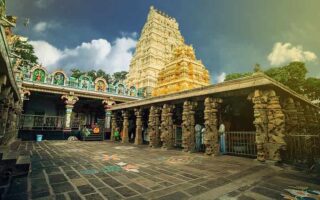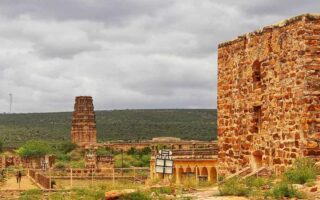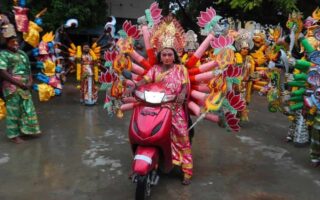Andhra Pradesh is abutted by Chhattisgarh, Orissa and Maharashtra in north, in the east it is bordered by Bay of Bengal, in the south is Tamil Nadu, and Karnataka is in the west. Andhra Pradesh is being placed on the Deccan Plateau where rivers Krishna and Godavari pass through the plateau and forms huge deltas before enrolling in Bay of Bengal. The capital of Andhra Pradesh, Hyderabad bears along with it the legacy in culture. You can see the presence of Buddhist and Hindu societies along with the primitive architecture. This is the state which ranks 2nd for the mineral wealth. Here you can find main industries pertaining to Biotechnology, Information Technology, Business Management, Pharmaceuticals and Construction.
After doing a deep study of the historic particulars of the Andhra Pradesh, you can get the ideas about the mind blowing Caves of Andhra Pradesh that are disseminated all over the region. These caves domiciles the statues of rock-cut styles of Lord Buddha, here some caves are very old that dates back to the primitive times. In today’s time the caves are a part of tourist attraction of Andhra Pradesh. From the study that was done during the excavations, it was noted that the Caves of Andhra Pradesh were from very olden times.
The Caves of Andhra Pradesh has their own significance. The Belum Caves has a underground passage, this is considered to be the natural architecture, this is also ranked 2nd in terms of its length next to the caves of Meghalaya. There is also the Borra Caves which is constructed near the Gosthani River and this cave is built with the deposits of limestones. Founded near the Krishna River is the Undavalli Caves, this is also very famous in Andhra Pradesh, this cave is believed to be discovered in the era of 4th and 5th centuries, the chief drawing card of the cave is the statue of Lord Vishnu. Surrounding the caves like Venkateshwara, Veera Brahman, Rokalla, the Yaganti Caves in this state gives the presentation of the pleasing aggregation of the nature, which is worth watching. The Narasaraopet where the primitive inhabitants were found, here is the location of the Guthikonda Caves, during the excavation of this cave from the archeological department founded a holder of sword which gave the result that this cave was from the time of the very earlier era.
The major languages spoken here are the Telugu with Hindi, Urdu. This place is the of rich and varied mosaic of cultures, here there are people of Hindus, Buddhist and Muslims which are placed in quite few areas. The tribes that can be found here are the Mandulas, the Gadabas, the Chenchus, the Yenadis, the Bagatas and the Banjaras. The food which is mainly consumed by the people here is the tamarind rice that is called the Pulihara. The festivals celebrated in Andhra Pradesh are Vanamaleeswara Swami which is a car festival, Visakha Utsav, Deccan Festival, Pongal, Makara Sankranti, Ugadi, Pongal and many more. The caves too contribute a major attraction in Andhra Pradesh along with the festivals, people and cuisines which makes Andhra Pradesh the known all over the country. The arts and crafts here cannot be ignored, which are universally known. The other places where tourist are crowded with are the Mecca Masjid, Birla Mandir, Charminar, Golconda Fort, Osmania, the Hi-Tec City and many more on the list.
Amaravati Archaeology
- Situation: Sattenapalli Taluk of Guntur District
- Importance: Site of Archaeology
- Chief Findings: Buddha’s Great Stupa
- Popular For: Country’s largest Stupa of Buddha
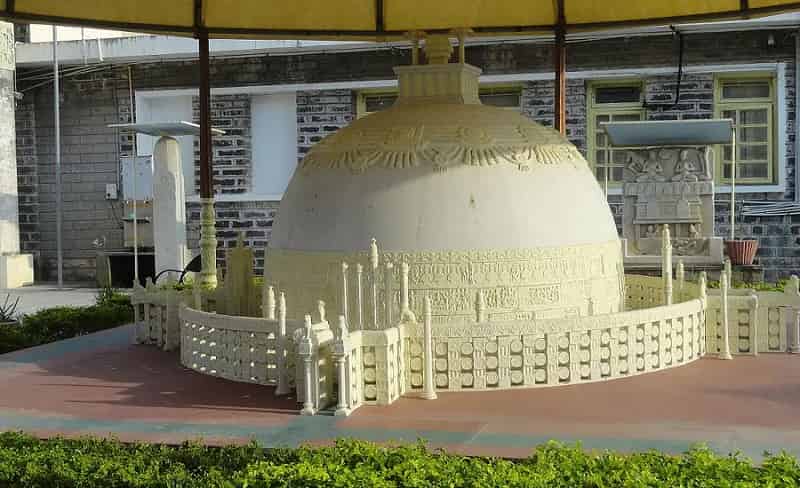
In the Guntur District’s Sattenapalle Taluk is situated the very popular Amaravati. Here you can find several temples which are famous among people, there is a temple dedicated to Lord Shiva, known has ‘Amareswara’, there are also many Buddhist figurines. The temple of Amareswara is considered very serene due to the three factors of the place one is the River Krishna, this is believed to be the most imperative Kshetra bearing a ‘Sthala-mahatmya’ and the last is the Sri Mahalinga Murthy this entire are personified at one place here.
The Stupa Relics
Amaravati is famed for its fortune trove of leftovers of Buddhist faction – sculptured panels, murals and carvings. Amaravati received its eminence as of the Mahastupa, the country’s biggest Stupa. It is finished with marble with a height of 6 feet and the width of 36.5 feet, and girded by a circulative alleyway, which was established in the 3rd century BC. The Mahastupa is locally known as Hillock of laps or Deepaladinne.
The uniqueness of its innovative builder is unknown even though a splinter of a pillar dedication is sited at the site, indicative of an involvement with Ashoka, in the 3rd century by the big Mauryan emperor. The Stupa was a reservoir for a quantity of minute relic caskets in addition to this it focuses on the immense religious Buddhist complex.
The Stupa of Amaravati symbolizes the set of stupas made of bricks bearing a stone slab veneering surrounding on the domes lower parts and the drum. Extravagantly engraved and sculptured in its affluent days, only its traces can be seen now. The sculptures in reprieve embellished in the interiors and exteriors of the Stupa and even in the base of the drum. The stupas are kept at the Government Museum, Chennai.
Its structural design and accompaniments are habitually to be contingent from its existing remains and many replicas engraved in relief on what formed the casing slabs, found at the site. The main festivals that are celebrated here are Navratri, Kalyana Utsav and Maha Shivratri.
Deccan Pre-Historic Rocks (Telangana)
- Situation: Hyderabad, Andhra Pradesh
- Importance: Archeological site
- Main Findings: Sculpted Granite Rocks
- Other Attractions: Gandipet, Hussain Sagar, Tombs of Qutb Shahi, Lumbini Park, Birla Mandir
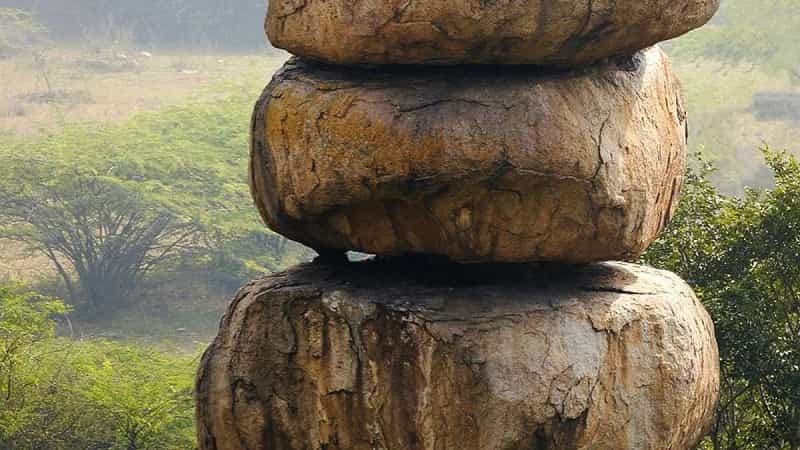
Hyderabad being the capital city of Andhra Pradesh is drawn with tourists in large numbers. Dated back from the 2,500 million years back, the Deccan Pre Historic Rocks were geologically launched. The delightfully sculpted rocks of granite were instituted in the world’s shield areas that are five in numbers.
Banjara Hills and Jubilee Hills at Hyderabad and in Secunderabad, the Mahendra Hills are the places when you can find such formation of rocks. The rock formations that are interesting are also to be found ahead of Kukatpally, in close proximity to Lingampally, inedible the railway track to Mumbai.
Kondapur (Telangana)
- Situation: At a distance of 90 kms from the northern side of Hyderabad in the Medak district
- Popular As: Town of Mounds
- Main Findings: Buddhist Relics
Positioned at a distance of 90 kms north to Hyderabad, it falls underneath the district of Medak. It is very popular as ‘Texila of the South’ and mentioned as ‘town of mounds’. The excavations found here during the archaeology goes backs from 3000 BC. Here you can have a look at the excavations like industrial buildings, silver, gold and copper coins from the era of Roman’s, and Buddhist complex remains preserved in Kondapur. Some excavations are still on the urge of getting excavated. Sculptures of megalithic graves and limestones are being excavated from nearby areas.
Yeleswaram
- Region: Nalgonda district, from Devarakonda around fifty four kilometers
- Major Find: Relics of Buddhist
- Relevance: Archeological Site
- Close Attractive Spots: Ethipothala falls, Nagarjunasagar Dam and Nagarjunakonda
From Andhra Pradesh’s Devarakonda, Yeleswaram excavation is around fifty three kilometers and from Macherla it is about thirty eight kilometers. This is located over Krishna River’s northern bank & it was established during the periods of Andhra and Buddhist in 1st century. Andhra Pradesh’s Yeleswaram excavation contains huge archeological value & this excavation is placed over the land in which numbers of relics of Microlithic, Megalithic complexes, Palaeolithic and Chalcolithic. The Archaeological Department of Andhra Pradesh that is located in the capital city Hyderabad is taking care of this excavation.
Borra Cave
- Location: At a distance of 90 to 95 kms from Vishakhapatnam
- Discovered in: 1807
- Main Attraction: Stalactites and Stalagmites Cave formations
- Recommended time to visit: November to December
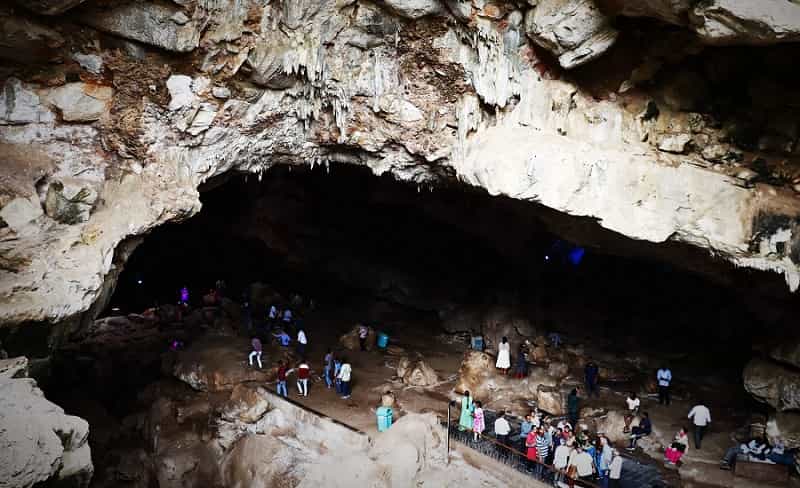
Borra Cave is placed in the Eastern Ghats in the Ananthagiri Hills which is approachable from Vishakhapatnam at a distance of 90 to 95 kms. This cave bears religious and historic grandness. This cave is located at the height of 1,400m over the sea level, occupying the area of 2 sq kms of the Eastern Ghats.
The Borra Cave was being founded in 1807, in the survey of Geological of India by William King George. There are tribals populated in the area of the cave for this people this place has a spiritual implication. There is the ‘Shivalingam’ in the cave deep inside; this is the linga above which there is the cow idol which is known as ‘Kamadhenu’, from the udder of the cow here the river Gosthani has its origin. The cave is lighted with 63 halogen and sodium vapor lamps, mercury lamps, this helps making the interior of the Borra Cave more dramatic and mind-bending, and this is done by the Tourism Development Corporation of Andhra Pradesh. Here is the possibleness of finding rubies during the mining; even you can find mines of mica all around the village here. The best recommended time to visit this place is between November and December.
Formation
The Borra Cave is rich in the formation has it is astoundingly beautiful. During the action of limestones in the Gosthani River this cave was formulated, when pressure maintained in the flowing river on the deposits of minerals, by this the limestones got dissolved and the caves goy formed. This process is a two-way process. The solidified irregular shapes of stalagmites are formed due to the trickling of the drops of dissolved limestones on the caves floor. Also the drops of water helped to form stalactites. After a certain point of time, the deposits of calcium in stalactites and stalagmites grow in the direction of upward and downwards severally and to form unlike parts of caves they even touch one other. There are some deposits even form wired shapes while some bears great structures that has gained religious grandness in the certain time period.
Prime Attraction
The interior of the Borra Cave is full of mattering structures like the temple, mushroom formation, a church, a mosque and many more things. On the ground of the caves you can have a look at the deposits of the sulphur, yellow-coloured; this flows from the solidified stalagmites and stalactites of the river Gosthani when out of the cave it moves towards Orissa.
There is a tour conducted for Borra Caves which is a one day tour called the Araku. This tour is arranged on daily basis, between 7.00 am to 9.00 pm. The charges for the tour including lunch are Rs.160 for adults and Rs.120 for children. The destinations covered in this tour are the Damuku View Point, Ananthagiri Coffee Plantation, Tyada Railway Tunnel, Araku Valley and Padmapuram Gardens.
Gudivada
- Situation: At the distance of 45 kms from Vijayawada in Krishna District
- Importance: Andhra Pradesh’s Archeological site
- Main Findings: Remains of Buddha Stupas
- Close by Attractions: Bhimeswara Swamy Temple
It is positioned at a distance of 45-km away from Vijayawada. Gudivada gained its name from the subsistence of the numerous temples from the earlier times. It was also popular as Vidarbhapuri as maintained by Khandeyayani Kaikaluru Silasasanam of A.D. 1628. This place has it existence from 2000 years and had flourished from the times of Satavahanas.
Here you can get a glimpse of the Buddhist and Jain relics. Other exclusive sites that are found here are ninety nine low heaps with remnants of Stupas of Buddhist. A prominent hammock in the shape of a cylinder which has the shape of a top in semi-spherical, this is identified as the most primitive Buddhist Stupa by the Department of Archaeology and is also acknowledged as a protected monument. It is believed to be among the seven Stupas of Buddhist.
Nandikonda (Telangana)
- Region: Nalgonda district, from Miryalaguda about sixty four kilometers
- Major Find: Structures of Buddhist
- Relevance: Archeological Site
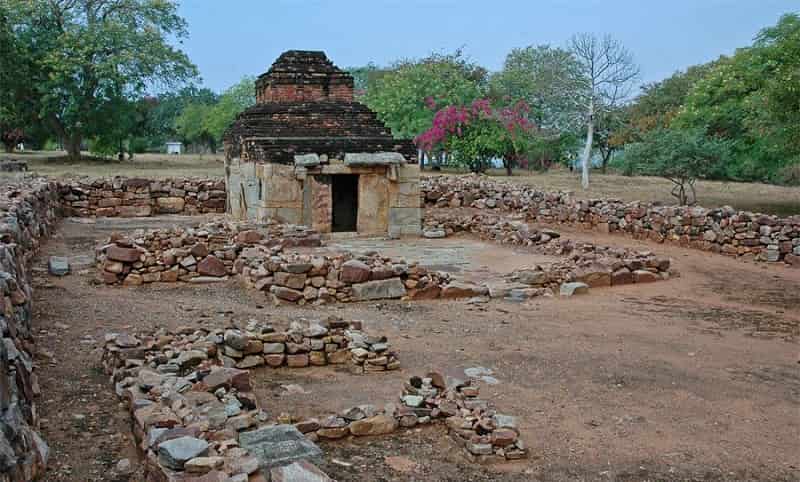
Andhra Pradesh’s this excavation is a tiny village that is located over the Krishna River. From the Miryalaguda it is far around sixty four kilometers. The prime structure of Nandikonda village Ikshvaku Citadel, it has beautiful ditch, wall, gates and quarters of army but it is placed inside the structure and a very huge stadium of rectangular shape. This location of Andhra Pradesh state is stated as Vijayapuri within the inscription which has been imprinted only over the pillars of this structure. There are some more structures of Buddhist such as pillared walls and monasteries that were uncovered at this place and few findings had been stored in essential Central Archeological Department.
Rangapur (Telangana)
- Situated: 8kms away to the eastern Achampet, District of Mahabubnagar
- Implication: Archaeological Site
- Major Findings: Buddhists Structures
The archaeological site of Rangapur is situated 8kms on the east side of Achampet on the bus route of (Mahabubnagar-Amrabad). Some of the archaeological findings brings out that the site of Rangapur was a major religious centre for the Hindus in the 7th century. The former inscriptions found here relevant to the twelfth century.
Salihundam
- Region: Srikakulam district, from Srikakulam it is around eighteen kilometers
- Relevance: Archeological site
- Major Find: Buddhist period’s stupas
- Historical Names: Salipetaka and Salipataka
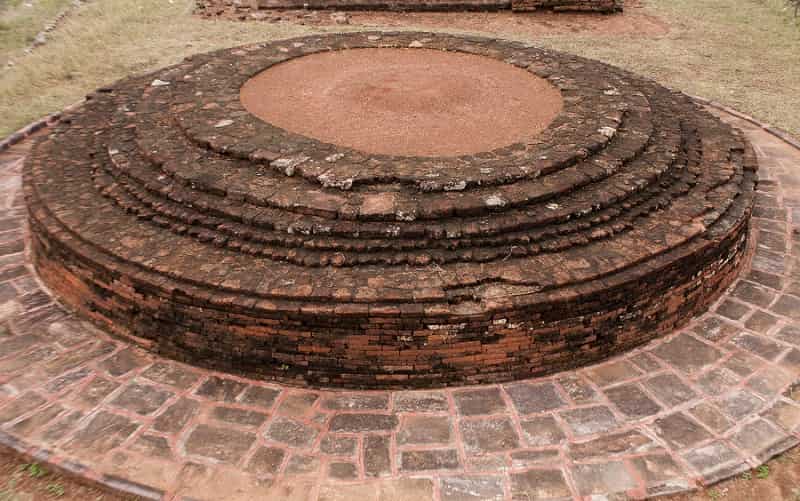
From Andhra Pradesh state’s Srikakulam, this excavation is about eighteen kilometers. Salihundam excavation is situated on the right of Vamsadhara River’s bank, and is around one hundred sixteen kilometers from Vishakhapatnam, it comes under the Andhra Pradesh district called Srikakulam. Salipetaka and Salipataka were formed previously under the modern Salihundam form.
The village has a lot of archeological importance because of historical monuments located over the hillock. You can see many stupas of Buddhist and large monastic complex situated within the beautiful surroundings. You can see the votive stupas, Mahastupa, Viharas and platforms. The stupas of Buddhist religion which have been excavated in the recent days are revealing the value of this location during the former days. It also includes different proof of ancient culture of Vajrayana. Here you can also see the Marichi and Tara at this place. From this spot the Buddhism religion started spreading towards the eastern countries and Sumatra. To secure these valuable and important monuments Archeological Department has put his hand forward.
Chippagiri
- Situation: At a distance of 21 kms from South East of Alur in Kurnool District
- Importance: Andhra Pradesh’s Archeological Site
- Main Findings: Prehistoric Traces
- Other Attractions: Srisailam, Adoni, Ahobilam
Chippagiri is positioned at a distance of 21-km to the south eastern side of Alur. Inscribed evidence depicts that this situate was underneath the power of Taila, the Chalukya ruler and the monarchs of Vijayanagar.
This village earned archaeological significance as it comprises a squat equipped hill, where draws of antediluvian colonization’s are found. The entrance of the fort is reanimated in 1944 and the main archeological interest in the Jain Temple is found on hill top in the gunpowder magazine.
Jeelakarragudem
- Situation: At the distance of 6.4 kms from Kamavarapukota in the Krishna district
- Importance: Andhra Pradesh’s Archeological site
- Main Findings: Buddhist Stupas
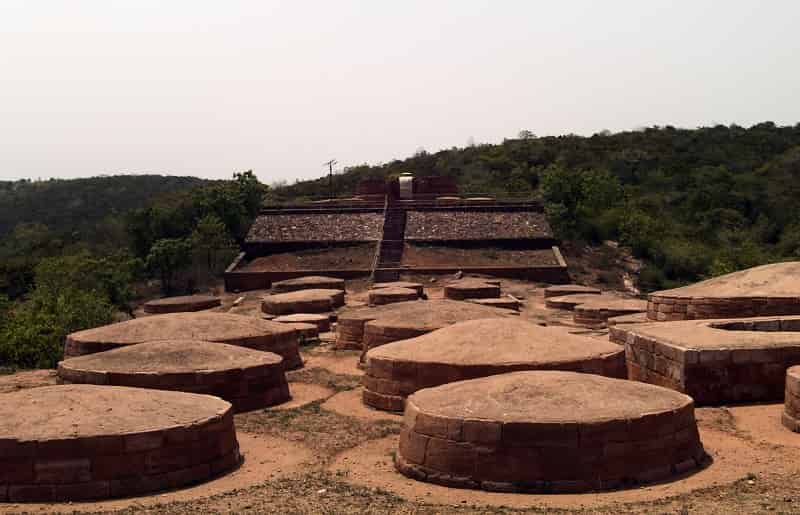
Jeelakarragudem, village belonging to Guntupalle is located at the distance of 6.4 kms from Kamavarapukota. You can see the immense picturesque hills surrounding the place. This place has been in existence since earlier 200 BC, when this place was occupied by the Buddhist aromas. After the Jains, this place was known as Jainavarigudem.
In the earlier times, some Buddhist Stupas were excavated by the Department of State Archeology; this Stupa was 30 inches in circumference and 10 inches in height situated on the hills nearby. Here you can also have a look at the Stupa made of marble; even you can have a glimpse of the six idols of Buddha. People visit in large numbers every year.
Nidamarru
- Region: Andhra Pradesh, district Krishna, on Mangalagiri’s west about four kilometers
- Major Find: Images of Buddhist
- Relevance: Archeological site
Nidamarru one of the historical excavations is situated around four kilometers on Mangalagiri’s west side. You need to cross the passing path by Tadikonda. This location has got its reputation due to the 4 essential images, which were founded within the village. The 4 pictures of Buddhist have been carved in the stone of black color. These images are available in Theosophical Society, it is located at Guntur. You can see oldest images of Buddhist in town.
Undavalli Caves
- Location: At the distance of 8 kms from Vijayawada
- Houses: Specimens of Sculptural models and Cut-in architecture
- Belongs to: 7th century AD
- Main Attraction: Statue of Lord Vishnu
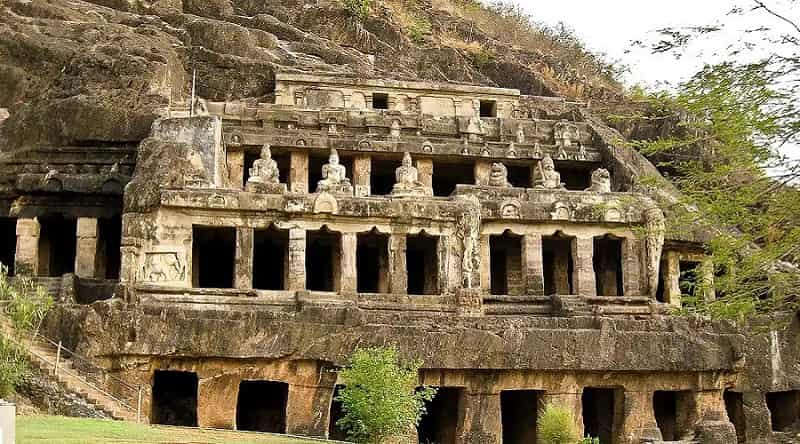
Undavalli Caves are placed in the village of Undavalli of Andhra Pradesh. This cave is located at the distance of 8 kms from Vijayawada and at the distance of 32 kms from the district of Guntur. The location of the caves is facing the Krishna River on the hill top.
History
From the history you can find that the carving of these caves were done in the 7th century. These caves have an association with the Vishnukundin Kings from 420 AD to 620 AD. The Undavalli Cave are dedicated to the Narasimha Swamy and the Anantha Padmanabha. From the historic findings you can find the evidences of Madhava Reddy who was the ruled this region under the Reddies of Kondaveedu, these caves were empowered to the Anantha Swamy. These caves were domicile for the Buddhist monks. The other shrines of the cave were devoted to Brahma, Shiva and Trimurti. Among the Hindus all over India these temples have grandeur.
Interior
The Undavalli Cave are a fine illustration of the rock-cut architecture of the Indian Buddhists. The main feature of these caves is the Lord Buddha’s statue which is 5m in length. Another attraction is the single granite block which bears the sculpture of Lord Vishnu.
From the study of the caves it is brought out that the sculptures of Vaishnava and Shiva have been added after some time. The architecture of the temple is recognised has from the Chalukyan Style. These sculptures give you an exhibition of the primitive era artisans. Since there is no electricity at this place you need to carry a candle or a torch to have a glimpse of the murals, frescos and many other sculptures.
Natural View
Apart from the beauty of architecture of the caves you can also have a look at the surrounding area. You can have a glance at the agricultural sight from the top of the caves. A walk along the river side is also a mind-blowing experience to get known to the local people of the region. A boat ride is also a wonderful thing to enjoy. You can also see the sight of children enjoying in the fields with their moms cropping hard.
